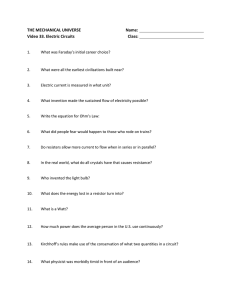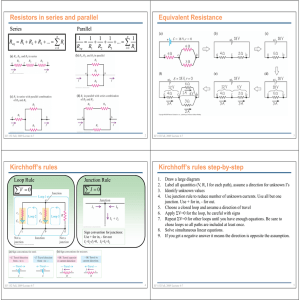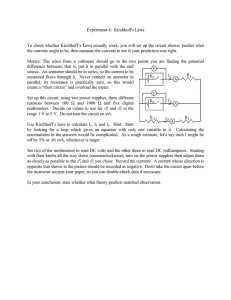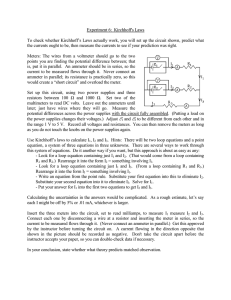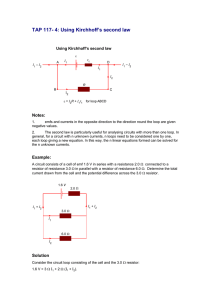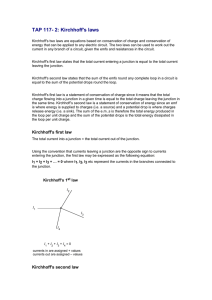Kirchhoff`s Rules Statement of Kirchhoff`s Rules
advertisement
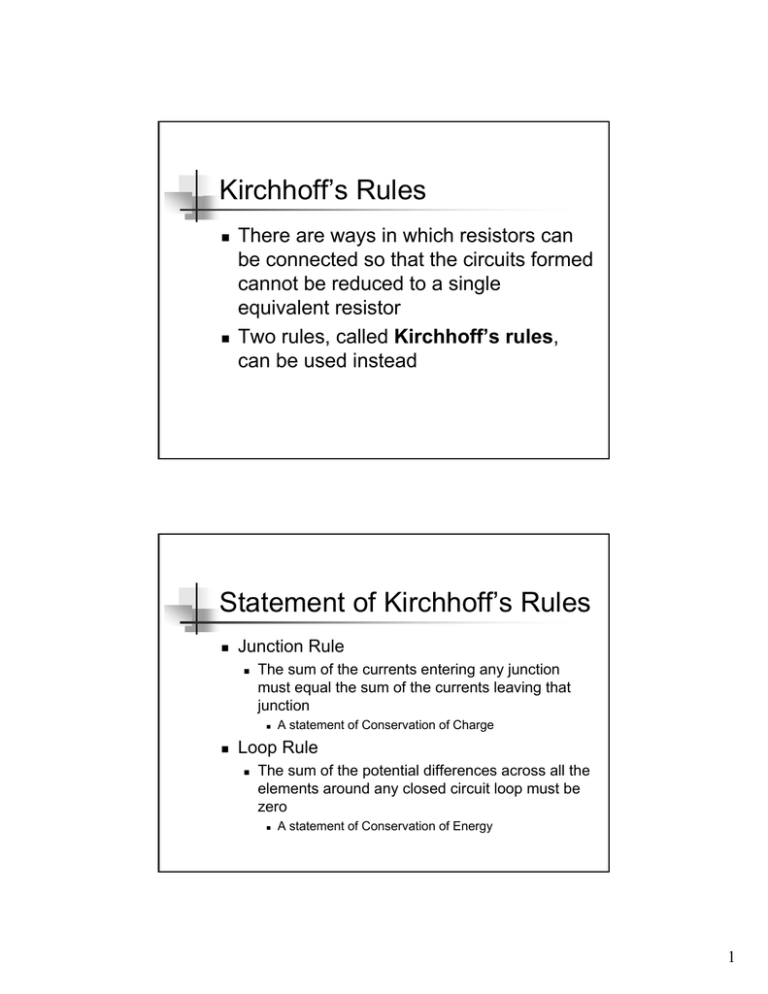
Kirchhoff’s Rules There are ways in which resistors can be connected so that the circuits formed cannot be reduced to a single equivalent resistor Two rules, called Kirchhoff’s rules, can be used instead Statement of Kirchhoff’s Rules Junction Rule The sum of the currents entering any junction must equal the sum of the currents leaving that junction A statement of Conservation of Charge Loop Rule The sum of the potential differences across all the elements around any closed circuit loop must be zero A statement of Conservation of Energy 1 Mathematical Statement of Kirchhoff’s Rules Junction Rule: Σ Iin = Σ Iout Loop Rule: ∑ ΔV = 0 closed loop More about the Junction Rule I1 = I2 + I3 From Conservation of Charge Diagram (b) shows a mechanical analog 2 More about the Loop Rule Start on point a and end on b. Direction of current, indicates which point is at a higher potential. In (a), the resistor is traversed in the direction of the current, the potential across the resistor is – IR In (b), the resistor is traversed in the direction opposite of the current, the potential across the resistor is is + IR Loop Rule, final In (c), the source of (electromotive force) emf is traversed in the direction of the emf (from – to +), and the change in the electric potential is +ε In (d), the source of emf is traversed in the direction opposite of the emf (from + to -), and the change in the electric potential is -ε 3 Kirchhoff’s Rules Equations In order to solve a particular circuit problem, the number of independent equations you need to obtain from the two rules equals the number of unknown currents Any fully charged capacitor acts as an open branch in a circuit (WHY??) The current in the branch containing the capacitor is zero under steady-state conditions Problem-Solving Hints – Kirchhoff’s Rules Draw the circuit diagram and assign labels and symbols to all known and unknown quantities. Assign directions to the currents. The direction is arbitrary, but you must adhere to the assigned directions when applying Kirchhoff’s rules Apply the junction rule to any junction in the circuit that provides new relationships among the various currents 4 Kirchhoff’s Rules Illustrated Kirchhoff’s Rules Determine the magnitude and direction of current through the various resistors. R1 ε1 R2 ε3 R3 ε2 R4 R5 R6 5 Kirchhoff’s Rules Assume a direction to traverse the loop. R1 ε1 R2 ε3 R3 ε2 R4 R5 R6 Kirchhoff’s Rules Assume a direction of current flow. I1 R1 ε1 R2 ε3 R3 ε2 R4 R5 R6 Trace out the current. Remember conservation of charge!!! 6 Kirchhoff’s Rules Assume a direction of current flow. I2 R1 ε1 R2 ε3 R3 ε2 R4 R5 R6 Trace out the current. Remember conservation of charge!!! Kirchhoff’s Rules Assume a direction of current flow. ε1 R2 ε3 I2 R1 R3 ε2 R4 R5 R6 Trace out the current. Remember conservation of charge!!! 7 Kirchhoff’s Rules Assume a direction of current flow. R1 ε1 R2 ε3 R3 ε2 R4 R5 R6 I2 Trace out the current. Remember conservation of charge!!! Kirchhoff’s Rules Assume a direction of current flow. R1 ε1 I3 R2 ε3 R3 ε2 R4 R5 R6 Trace out the current. Remember conservation of charge!!! 8 Kirchhoff’s Rules Assume a direction of current flow. R1 ε1 R2 ε3 R3 ε2 R4 R5 I1 R6 Trace out the current. Remember conservation of charge: I1 = I2 + I3!!! Kirchhoff’s Rules Pick a starting point for each loop. R1 ε1 R2 ε3 R3 ε2 R4 R5 R6 9 Kirchhoff’s Rules Traverse the loop in the direction YOU have chosen. End where you start!! R1 ε1 R2 ε3 R3 ε2 R4 R5 R6 Keep track of all the Potential differences encountered and sum to zero. -I1 R1 + -I3 R3 + ε2 + -I1 R6 + -I1 R4 + ε1 = 0 Kirchhoff’s Rules Traverse the right loop in the direction YOU have chosen. End where you start!! R1 ε1 R2 ε3 R3 ε2 R4 R5 R6 Keep track of all the Potential differences encountered and sum to zero. ε3 + -I2 R5 - ε2 + I3 R3 + -I2 R2 = 0 10 Kirchhoff’s Rules Summary: -I1 R1 + -I3 R3 + ε2 -I1 R4 -I1 R6 + + + ε1 ε3 + -I2 R5 - ε2 + I3 R3 + -I2 R2 I1 = I2 + R1 ε1 = 0 = 0 I3 R2 ε3 R3 ε2 R4 R5 R6 Kirchhoff’s Rules Let’s calculate current and charge for a small circuit which appears in many, many electronics. 11 Kirchhoff’s Rules (RC – circuit) a R b C ε As soon as switch is thrown into position a, there is a current flow throughout the entire circuit. After a very long time, current stops flowing through resistor R. This is equivalent to stating that the potential difference across R is zero after a long time after the switch is thrown to position a. (Charge stops “flowing” and is stored in the capacitor). Kirchhoff’s Rules (RC – circuit) a R b C ε q Applying Kirchoff’s rules: dq ε = iR + ; i = C dt dq q dq ε = R + ⇒ εC = RC +q dt C dt εC − q − q − εC dq dq dq ⇒ = ⇒ = εC − q = RC dt RC RC dt dt a ⇒ a f − dt dq = RC q − εC a f f 12 Kirchhoff’s Rules (RC – circuit) a R b C ε Applying Kirchoff’s rules: ε = iR + leads to the expression: z Q 0 q dq ; i= C dt dq 1 =− q − εC RC z t dt' 0 Kirchhoff’s Rules (RC – circuit) z Q 0 dq 1 =− q − εC RC z t dt' 0 a R b C ε Thus the total charge on the capacitor builds up over time, and the current through the circuit comes to a halt! (All potential difference is across the capacitor and none over the resistor.) The total charge is expressed as: F GH Q(t ) = εC 1 − e − t RC I JK 13 Kirchhoff’s Rules (RC – circuit) F GH Q(t ) = εC 1 − e − t RC I JK Kirchhoff’s Rules (RC – circuit) a R b C ε What about discharging the capacitor through the resistor R? Wait a really long time (t >> RC), and switch S to position b. 14 Kirchhoff’s Rules (RC – circuit) Applying Kirchoff’s rules: 0 = iR + leads to the expression: z q dq ; i= C dt z 1 t dq =− dt ' q RC 0 F GH Q(t ) = εC e − t RC I ; RC ≡ τ JK c Kirchhoff’s Rules (RC – circuit) F GG H Q(t ) = εC e − t τc I JJ K 15 Verify RC – Circuit Discharge! F Q(t ) = εCG e GH − t τc I JJ K Since Q is proportional to the potential difference, we can measure the potential difference across a capacitor as a function of time! Let’s DO IT (DEMO). 16
